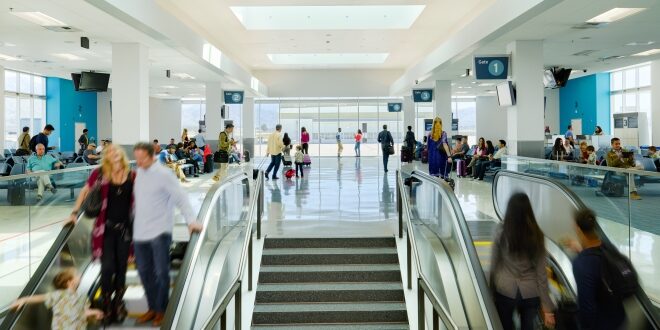That’s the opinion of Mark Gibbs, director of aviation at San Bernardino International Airport, who has seen much happen in the 20 years he has worked there.
Gibbs, 50, a Riverside native, has watched the former Norton Air Force Base go from an airplane maintenance and cargo facility to a carrier of commercial passenger flights.
The airport, which covers more than 1,300 acres, has also become a major player in the Inland economy. Since 1994, when it ceased to be a military installation and was turned over to civilian use, San Bernardino International has pumped an estimated $3.6 billion into the Southern California economy and created more than 17,000 jobs, according to the San Bernardino International Airport Authority.
“We’ve more than replaced the jobs that were lost when the Air Force base closed, which was very important,” said Gibbs, who has held the aviation director title for the last 10 years. “We’ve done a lot of things here that we’re very proud of.”
The resurgence of Ontario International Airport has been getting all the media attention recently, but San Bernardino International deserves some recognition for its growth as well, said Paul Granillo, president and chief executive officer of the Inland Empire Economic Partnership.
“It’s created a lot of jobs and become a major cargo airport,” Granillo said. “It’s also made it easier to fly from the Inland Empire to San Francisco and Las Vegas. Those are all major accomplishments.”
Gibbs spoke with IE Business Daily about landing Breeze Airways, San Bernardino International’s first commercial carrier, the possibility of getting International flights, and where the airport might be in five years.
IEBD: In August, San Bernardino International Airport got its first commercial flights when Breeze Airways, a discount airline, began daily round-trip flights to San Francisco. How big a milestone was that?
Mark Gibbs: It was big, and it took us a long time to get it, but it’s opened a whole new market for us. Ten years ago, all we had was MRO (maintenance, repair, and overhaul), and our goal back then was to get passenger flights. We now have all five of the categories that make it possible for an airport to function properly.
IEBD: What are those?
MG: MRO, general aviation, corporate aviation – meaning the business of private jets – air cargo and passenger flights. When you get all of those, then you can serve your market, which is always regional. The smallest airport never serves just a city.
IEBD: Are passenger flights the most important?
MG: I wouldn’t say that. I don’t think one is more important than the other. They all fit together, and you need all five of them to succeed.
IEBD: You had several false starts before finally persuading Breeze to come to San Bernardino. Why was that so difficult?
MG: Commercial airlines are risk-averse. They’re very conservative, and they spend a lot of time researching a market before they commit to something. They don’t make a deal unless they know the market is right, and that slows the process. But it was very important, for the Inland Empire, for this to happen.
IEBD: Why so?
MG: Because this market is so underserved. Besides us, there are only six commercial airports in Southern California: Los Angeles International, Burbank, Glendale, Long Beach, John Wayne in Orange County and Ontario International. Seven if you count Palm Springs International. We have people from driving from here to Los Angeles International, which is ridiculous. The Inland Empire is a big market. It needs more airport options.
IEBD: Do you have more corporate-owned jets or more jets that are owned by individuals?
MG: We don’t distinguish between the two. We have a lot of both, and we put them all into one category.
IEBD: How often do the corporate jets fly?
MG: During the first 11 months of this year, we had about 8,640 corporate flights, and by the end of the year we expect to be close to 10,000. To put those numbers in perspective, 10 years ago, in 2012, we had 132 corporate flights. So it’s an important part of what we do.
IEBD: Will you try to attract more passenger flights?
MG: I think so. In February, Breeze is going to start passenger flights from here to Hartford, Conn., and Las Vegas. Having flights to the east coast is big, and having flights to San Francisco is big, I think the Las Vegas flights, once they start, are going to be a lot bigger. When we announced the San Francisco flights, all people were asking was when we were going to get Las Vegas flights. And San Francisco is a great market, you can go anywhere in the world from San Francisco. But going to San Francisco is not like going to Las Vegas.
Q: How did you end up with Breeze, a discount airline based in Cottonwood Heights, Utah that most people probably haven’t heard of?
MG: We presented the data to them, and we were able to show them this is an underserved market. They were also attractive because of their owner, David Neeleman. Besides Breeze, he has started four airlines – Jet Blue, Azul, Westjet Airline, and Morris Air – and they’re all still in business, except for Morris Air, which was bought by Southwest Airlines in 1994, two years after it started. All four of those made money, which is impressive. David Neeleman knows how to run an airline.
IEBD: Will cargo always be San Bernardino International’s top priority?
MG: I don’t think so. Like I said, we don’t try to put one aspect of the airport over any of the others. They’re all important. We’re the 30th largest cargo airport in the United States so I wouldn’t say we’re moving away from that.
IEBD: You have been partnered with Hillwood Development Co. LLC for 20 years. They’re responsible for most of the industrial development around the airport. What has that been like?
MG: It’s worked out well. They actually built the Amazon and the Fed Ex facilities where the Air Force base used to be, and they built the Stater Bros. headquarters next door. They’ve also brought in a lot of Fortune 500 companies, and they’ve all stayed here. Our relationship with Hillwood has been a very good one.
IEBD: How much have they developed?
MG: About 16 million square feet. At this point, there’s not a lot of property left for them to work with.
IEBD: Is it accurate to say that Norton Air Force Base is in the past and that the transition from a military installation to a commercial airport is complete?
MG: Yes, but it was a difficult process that took about 10 years, and at times it was frustrating. There was a lot of environmental work, a lot of cleaning up, that had to be done before anything could be built here.
IEBD: In 2017, Volaris was supposed to start round-trip flights between San Bernardino International and Guadalajara, but those plans fell through. Are you still pursuing international flights?
MG: We want to have flights to and from Mexico – I think every commercial airport wants to go there – but the Federal Aviation Administration has some concerns about safety, and airlines based in Mexico are not allowed to add U.S. flights until those issues are resolved. The FAA downgraded them in 2021. Any flights into the United States that started before that can still operate, but they can’t start any new ones.
IEBD: Where do you see San Bernardino International five years from now?
MG: I think we’ll be putting a lot of emphasis on more commercial flights. We’ll still do airplane maintenance because we have to. All airplanes need the same kind of maintenance, and you must provide that. You can’t just have a runway. But in our case passenger flights have the most potential for growth.
 IE Business Daily Business news for the Inland Empire.
IE Business Daily Business news for the Inland Empire.


